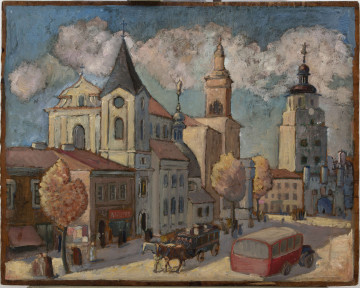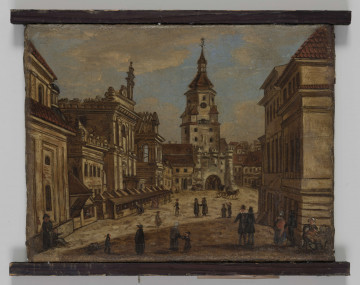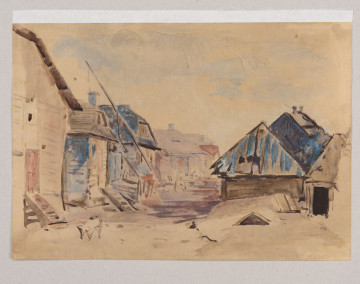
Krakow suburb
circa 1926-1939
National Museum in Lublin
Part of the collection: Polish landscape painting (19th–1st half of the 20th c.)
For Trachter, the key artistic event was his stay in France in the second half of the 1920s, where he became associated with the international milieu of the École de Paris. The momentous artistic explorations and violent experiments of the early part of the century were assimilated at this time. Artists continued and combined different traditions of modernity – they followed the moderation and order of Cézanne's painting, the geometrisation of Braque's forms, the expressionism of Roualt and Derain. The disparate styles of modernity of Soutine, Modigliani and Kisling were emerging.
Trachter read and interpreted the models in his own way, paying particular homage to the work of Cézanne: ‘I consider Cézanne to be the greatest painter of our age, he is a painter who paints light, sun, water, air brilliantly, a passionate colourist, drawing superbly. However, his opponents say that he could not draw, they are wrong, he had to draw like that, it suited his rhythm, I consider his still lifes, finished works, to be his best paintings’. The Paris trip and fascination with Cézanne's work changed Trachter's style. The artist moved away from careful, factual painting shots saturated with warm impressionistic light and colour and turned to compositions based on a geometric framework and classical order. His landscape of the town of Saint-Paul de Vence, piled steeply up, enclosed by cubic house forms and crowned by a high tower of a defensive castle, comes from a later phase of the painter's work and is a clear testimony to his search for moderation, order and permanence as aesthetic principles. It depicted the intimate buildings of a historical town in a system of modern blocks and planes. Trachter's Landscape follows the path of painterly portraits of L'Estaque, a city made famous by the views of Cézanne and Braque. The dense buildings in Trachter's painting are a compact, spatial mass of buildings, appearing as rocks against the sky. The rhythm of architectural forms in Trachter's painterly interpretation acquires the character of natural forms, expressing the universal and metaphysical order of nature.
Marcin Lachowski
Author / creator
Dimensions
cały obiekt: height: 63 cm, width: 53 cm
Object type
painting
Technique
oil technique
Material
canvas, oil-based paint
Creation time / dating
Creation / finding place
Owner
The National Museum in Lublin
Identification number
Location / status

circa 1926-1939
National Museum in Lublin

1801 — 1900
National Museum in Lublin

1801 — 1900
National Museum in Lublin
DISCOVER this TOPIC
Museum of King Jan III's Palace at Wilanów
DISCOVER this PATH
Educational path